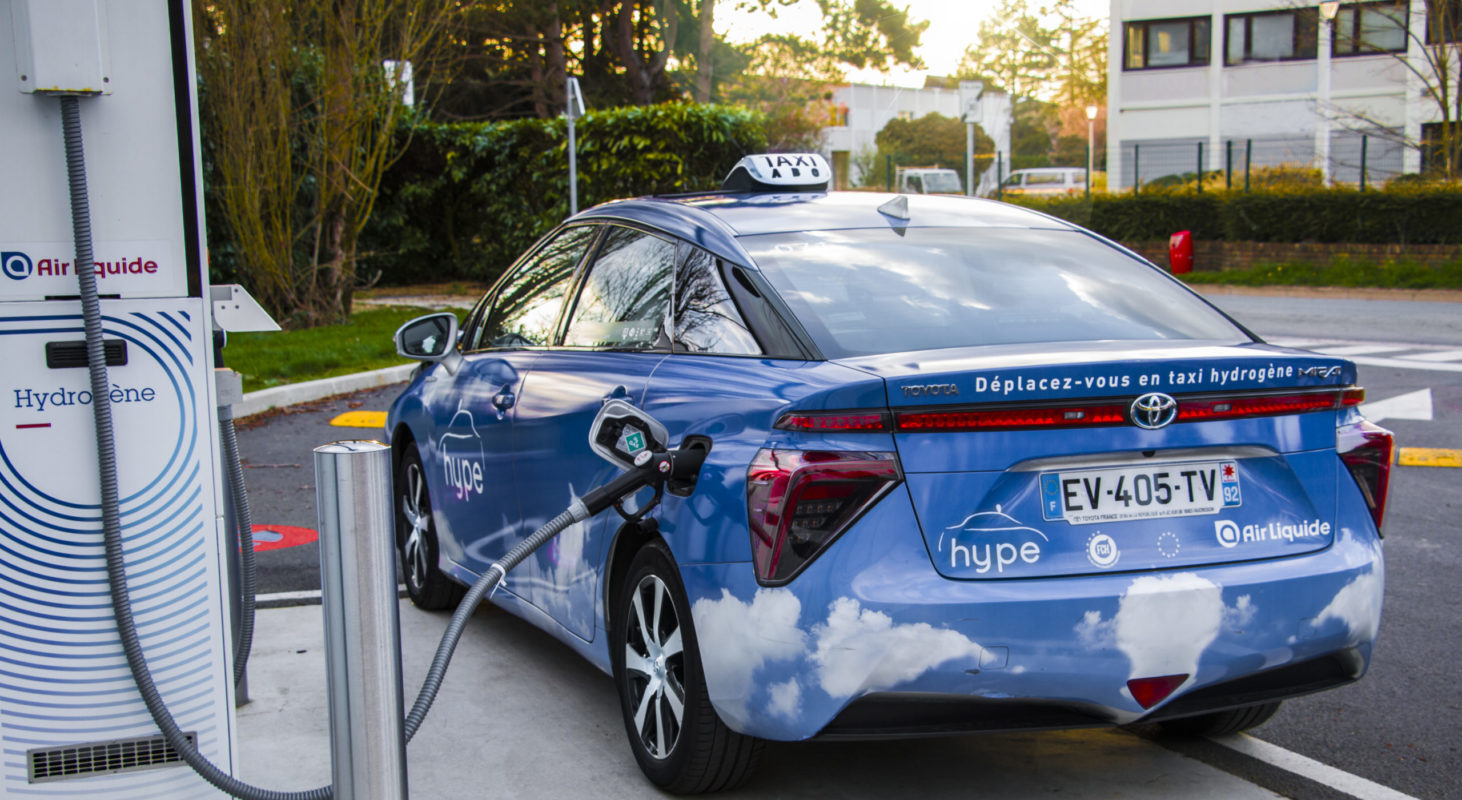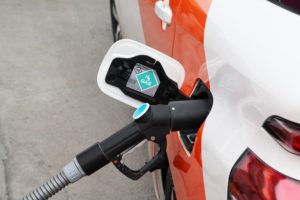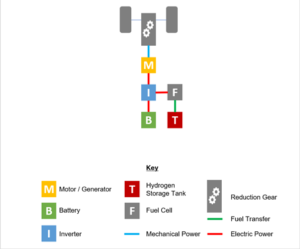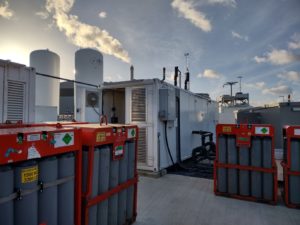
- Categories:
- News
- /
- Project Update
Hydrogen – your fuel of the future?
This article was originally written for Private Hire and Taxi Monthly Magazine as part of the ZEFER project
Electric is the future of transport.
Emissions from transport, causing environmental issues such climate change and poor urban air quality, are on the rise.
And this brings a demand for zero emission technologies.
But the solution for taxi and private hire vehicles may not necessarily be battery electric.
Hydrogen is the most abundant element in the universe and can be used in a fuel cell to produce electricity to power vehicles.
Fuel cell electric vehicles (FCEVs) use compressed hydrogen gas and oxygen from the air in a reaction that generates electric power for the motor and emits water from the tailpipe – no greenhouse gas emissions.
There are now several FCEVs on the market, the most popular is the Toyota Mirai (‘Mirai’ meaning ‘Future’ in Japanese) which is the vehicle of choice for a five year pan-European project called ZEFER (Zero Emission Fleet vehicles for European Rollout, funded by Europe’s Clean Hydrogen Partnership), researching the potential application of hydrogen in high mileage fleets such as taxis and private hire vehicles.
The 4-seater Mirai has a fuel tank capable of holding 5 kg of hydrogen which is equivalent to around 500 km on the road; its top speed is 179 km/h and can accelerate 0-100 km/h in 9.6 seconds.
170 Toyota Mirais have been deployed across London (50 for Green Tomato Cars), Paris (60 for Hype) and Copenhagen (60 for DRIVR) for private hire and taxi operations, with an additional 10 Mirais for London Metropolitan Police, as part of the project.
As passengers are increasingly eco-conscious, and major cities commit to Clean Air or Low Emission Zones, zero emission vehicles are in demand.
Range anxiety and recharge times are potential barriers to adopting battery electric vehicles, and sales of plug-in hybrid vehicles will soon be banned alongside petrol and diesel.
With similar refuelling times and process to conventional vehicles, hydrogen, could fill that gap.

Peter Joseph, one of the first Mirai drivers at Green Tomato Cars, is a fan of the vehicle’s credentials.
“We all have to do our bit for the environment and the Mirai is at the forefront of that technology,” he said.
“The car is lovely to drive, like you’re almost floating on air as you take off as it’s so smooth and quiet.
“It’s really comfortable and ticks all the boxes for me and my passengers.
“I’ve had no problems at all with safety and I’ve always felt safe driving the car.
“When I first started, especially in the first six months, I had customers who knew that hydrogen was flammable and were keen to know the safety levels of the car.
“Part of my induction involved someone from Toyota talking us though their research into hydrogen and protecting the tanks to make sure everything runs above board so I’m able to reassure any passenger concerns.”
Since the first 25 Mirais were deployed to Green Tomato Cars in April 2018, over 7 million kilometres have been driven as part of the ZEFER project, using 72,000 kg of hydrogen – the largest dataset of its kind in Europe.
An additional 25 Mirais were added in October 2019, and according to the latest project data, the Mirais used by Green Tomato Cars averaged 180 km and 14 journeys per day, and 31 km/h.
The average annual distance driven by each FCEV taxi is 48,000 km; this compares to the fleet’s petrol/diesel and plug-in hybrid vehicles, which average 39,000 km/year.
Over the course of all these kilometres, and the inevitable collisions that occur, there have been no dangerous incidents involving the release of hydrogen or problems with the fuel cell system, and concerns have eased over the years.
One thing drivers have noted is the seasonal variations in fuel efficiency between summer and winter months.
Generally, temperature has a negative correlation with vehicle energy consumption (i.e., fuel efficiency is lower in winter) due to factors including: reduced battery and mechanical efficiency, greater use of cabin heating during the winter and increased wind resistance.
Data from the ZEFER vehicles in London shows that fuel economy can be as low as 89 km/kg in Jan-19, compared to 119 km/kg at its highest in Sep-20; the average across the year is 105 km/kg.
Of course, fuel, and refuelling, is an important factor in transport operation, costs and emissions.
The zero emission credentials of FCEVs are reliant on hydrogen produced from renewable sources.
Traditionally, hydrogen has been extracted using fossil fuels in a process called steam methane reforming (SMR), although this is not necessarily the case for hydrogen used in transport applications.
Electrolysed hydrogen, a process of using electricity to split water molecules into hydrogen and oxygen, (referred to as ‘green hydrogen’ when using renewable energy), offers a true net zero solution that can integrate wind and solar sources of energy.
This integration allows hydrogen to work alongside battery electric, to utilise excess electricity for hydrogen production and fill the gaps during intermittent production.
Filling a fuel cell electric vehicle with hydrogen gas is a broadly similar experience to filling a conventional internal combustion engine vehicle with diesel or petrol and takes place at a hydrogen refuelling station (HRS).
A typical passenger car FCEV operates with 5 kg of hydrogen on board at 700 bar (700 times atmospheric pressure); larger vehicles have more space available to store the fuel, and therefore generally use 350 bar storage which uses cheaper cylinders – for example a bus might store around 25kg of hydrogen in roof-mounted cylinders at 350 bar.
At a HRS, hydrogen is stored at 200 bar, then compressed to 900 bar and cooled to -40C for high pressure dispensing, filling a 5 kg tank in as little as 5 minutes – a useful perk for saving drivers time.
HRS dispensers are superficially similar to those used for conventional fuels in that they have a nozzle and a trigger to release the hydrogen.
The processes involved, from hydrogen production, compression, storage, cooling, and dispensing, is complex and energy intensive, and is currently one of the main drawbacks of hydrogen fuel for transport.
HRS are relatively new and expensive, and therefore few of them and can be susceptible to breakdowns.
Drivers often report pumps are out of service and travelling long distances to find the next nearest station; data from ZEFER however shows that HRS are 89.9% available on average.
High mileage applications require regular access to hydrogen fuelling stations, of which there are only 12 across the UK including 6 in and around London.
The map of HRS across Europe is more optimistic, the majority of HRS are in Germany, and Paris has plans for 20 new stations by 2024 to support taxi deployment, in addition to the three utilised by Hype as part of the ZEFER project.
Hydrogen Mobility Europe (H2ME), along with other similar projects, has funded the installation of more than 30 HRS across Europe to date, and has committed to a target of 49 by the end of this year, to assist the transition to hydrogen for transport and develop a profitable business case.
Deploying captive fleets close to HRS optimises hydrogen demand to create an efficient and cost-effective fuel for operators, however it will take time for the infrastructure network to spread organically.
Read more: An Introduction to Hydrogen Fuel Cell Electric Vehicles and Refuelling Stations
Victor Lejona is a senior technical specialist at Cenex, a low emission transport consultancy and research organisation involved in real-world hydrogen transport trials across the UK and Europe, including ZEFER.
“Hydrogen will suit sizeable cities with large taxi demand and where enough refuelling infrastructure is available,” he said.
“If the HRS are located in the right places, they can be very convenient for both the taxi fleet and the hydrogen provider.
“For example, the Hype fleet in Paris are operating 160 hydrogen taxis, and often refuel at the two main city airports which is extremely convenient for taxi drivers, as they can use their trips to pick up or drop off passengers at the airport without any ‘stem’ or ‘dead’ mileage,
“Over the next ten years both vehicles and infrastructure will still need to be heavily incentivised by national or EU governments, and joining forces with other local fleets, such as heavy vehicles or commercial vehicles, will allow the business case to flourish as prices will decrease from the high volumes of hydrogen dispensed.
“If we build the hydrogen refuelling infrastructure and get serious about air quality and climate change, hydrogen-powered commercial transport could become a significant part of the world economy”.
Lightweight, quick to refuel and zero tailpipe emissions make hydrogen an ideal transport option for private hire and taxi vehicles, however the cost and availability of infrastructure remain barriers to widespread adoption.
Finding the right zero emission technology for the right application is essential in achieving the 2050 carbon targets and reducing transport’s emissions.
For many, battery electric will be the way forward; for high mileage applications it could be hydrogen.
The results from hydrogen vehicle trials across Europe highlight the benefits and impacts, and tackle the barriers, and only by growing confidence in the technology can it integrate into our transport network in the future.

